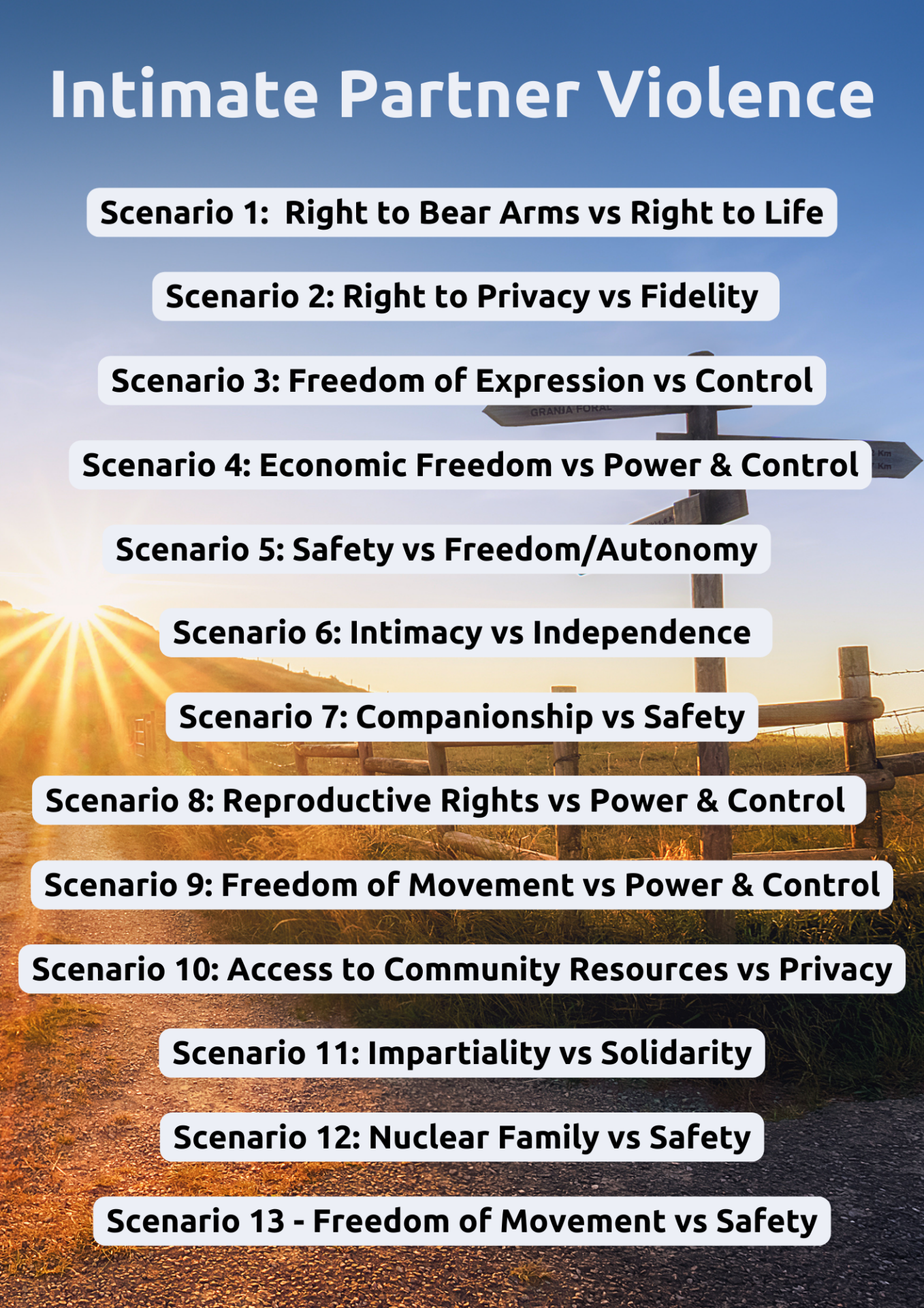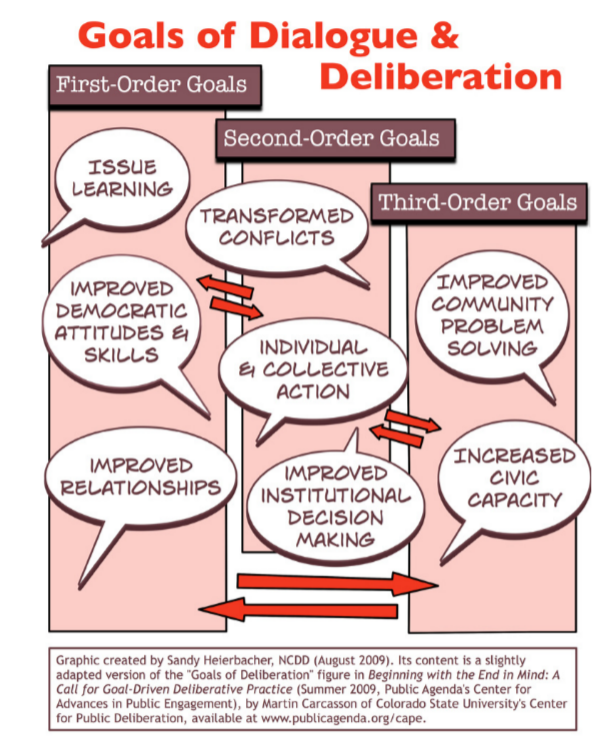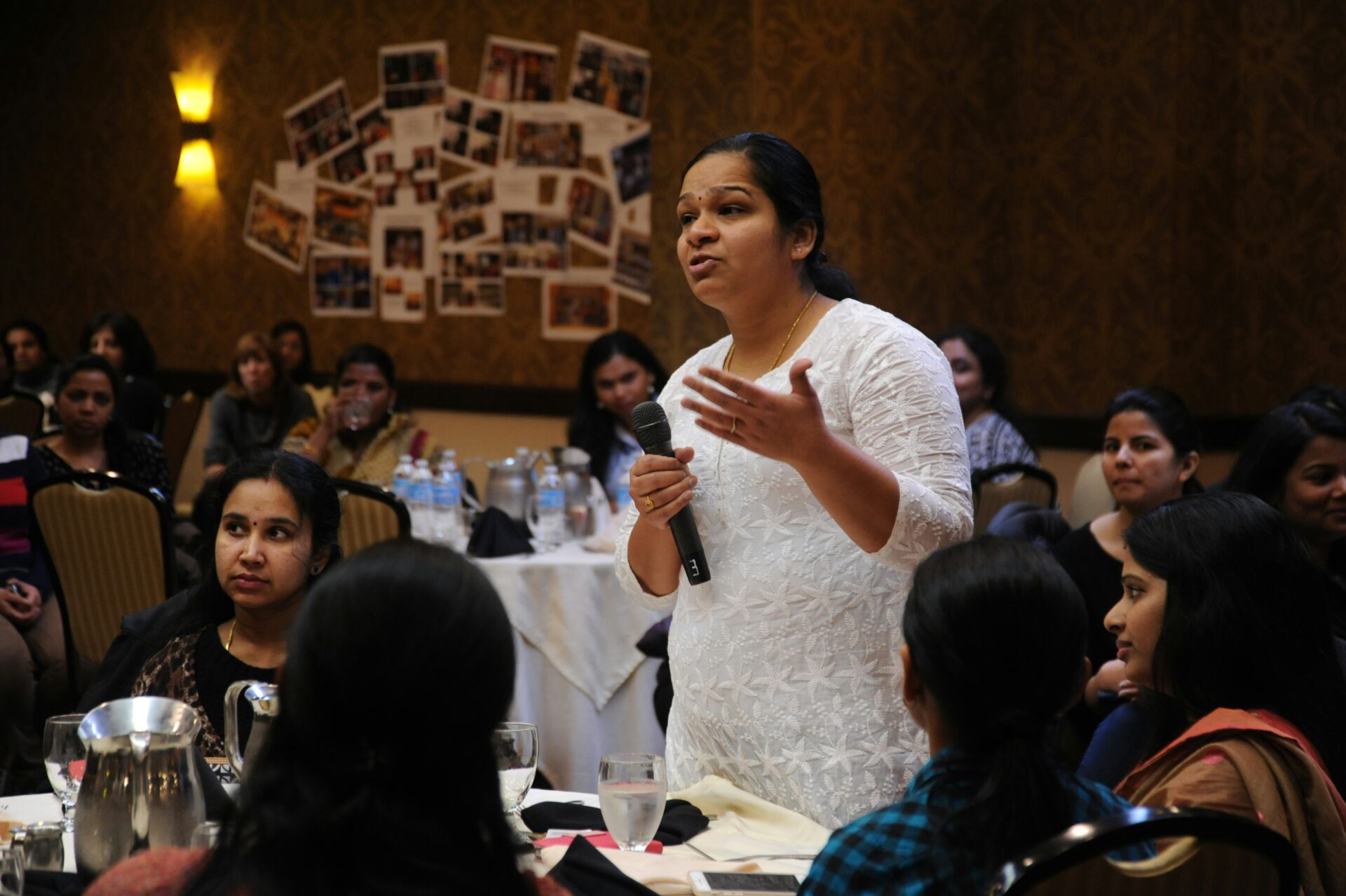You may think there is little to debate when it comes to intimate partner violence – you don’t find many people advocating for abuse. But the reality is that communities still require complex strategies to address the underlying issues that contribute to this pervasive problem. In this post, the concept of deliberation will be explored, and the issue of domestic violence will be viewed through a wicked problem lens. The objectives of this project will be explained, along with an examination of the topic’s engagement stream and deliberative ripeness. A few sections are devoted to potential challenges and focus on underrepresented populations.
Establishing Definitions:
Before the conversation can begin, there are a few housekeeping issues to attend to first – starting with factual claims. More specifically, definitional claims provide all parties with a common definition to serve as the foundation for any argument. (Carcasson, n.d)

What do we mean by “domestic violence”?
According to Michael P. Johnson, there are three categories of domestic violence (DV):”…(a) violence enacted in the service of taking general control over one’s partner (intimate terrorism), (b) violence utilized in response to intimate terrorism (violent resistance), and (c) violence that is not embedded in a general pattern of power and control but is a function of the escalation of a specific conflict or series of conflicts (situational couple violence).” (2005)
The Office on Violence Against Women within the US Department of Justice describes domestic violence as: “a pattern of abusive behavior in any relationship that is used by one partner to gain or maintain power and control over another intimate partner. Domestic violence can be physical, sexual, emotional, economic, psychological, or technological actions or threats of actions or other patterns of coercive behavior that influence another person within an intimate partner relationship. This includes any behaviors that intimidate, manipulate, humiliate, isolate, frighten, terrorize, coerce, threaten, blame, hurt, injure, or wound someone.” (2023)
Domestic violence is also used interchangeably with “Intimate Partner Violence” (IPV). “The National Violence Against Women survey defined Intimate Partner Violence as ‘rape, physical assault, and stalking perpetrated by current and former dates, spouses, and cohabiting partners — with cohabiting meaning living together at least some of the time as a couple. Both same-sex and opposite-sex cohabitants are included in the definition.’” (Oklahoma Partnership for Public Deliberation, n.d., p 2)
What do we mean by “deliberating”?
Nabatchi and Leighninger define deliberation as “thoughtful, open, and accessible discussion about information, views, experiences, and ideas during which people seek to make a decision or judgment based on facts, data, values, emotions, and other less technical considerations” (2015, p 14-15)

Carcasson and Sprain point out there are “multiple conceptions of deliberation itself: deliberation as a form of talk…, deliberation as a way of making collective decisions and reaching mutual understanding…, deliberation as careful weighing of alternatives…, deliberation as a social and analytical process…, and deliberation as an organizing principle for political life…” (2016, p45)
This project incorporates facets of each of those definitions. This Serious Game (SG) is meant to stimulate conversations, promote understanding, illuminate gaps and barriers, and advocate for policy.
With this project, the issue of domestic violence is viewed through a “Wicked Problem” lens.
What makes it “wicked”?
“Wicked problems are problems that have no possible technical resolution but rather are primarily defined in terms of positive but competing underlying values that we must identify, put on the table, and find ways to work together to negotiate the tensions that inevitably arise.” (Carcasson M., 2020)
“…positive but competing underlying values …”:
- Accountability
- Right to Culture
- Economic Freedom
- Economic Security
- Companionship
- Power & Control
- Privacy
- Independence
- Safety/Protection
- Right to Bear Arms
- Right to Life
- Freedom/Autonomy
- Loyalty/Fidelity
- Intimacy
- Impartiality
- Solidarity
- Lawfulness
- Obedience
- Respect
“…the tensions that inevitably arise…”
- Power & Control vs Safety & Security
- Lawfulness vs Autonomy
- Base Impulse vs Purposeful Intention
- Avoid Mass Incarceration vs Appropriate Response to Crime
- Privacy vs Harm Reduction
- Cultural Reverence vs Freedom/Autonomy
- Retributive Justice vs Restorative Justice
- Traditional Gender Roles vs Gender Equality
- Self-Determination vs Safety
Wicked Problem Slide

Deliberative Ripeness
Primarily involves tensions between positive values
Offender wants respect and obedience, freedom, privacy, intimacy.
Victim wants security, safety, respect, freedom.
Major stakeholder groups realize the need for action
Some offenders want to stop, most offenders do not want to be involved in the justice system, and/or do not want to lose partner or children.
Victim wants to remain a family, wants physical safety, emotional intimacy, and equity.
Necessary action by many stakeholders
It may seem like the offenders are the only stakeholders that require action, but victims also require behavioral change such as re-prioritizing values, finding empowerment, and protecting children.
Issue dominated by interest groups, relies on good v evil
As previously stated, less abuse is still abuse. Compromise may convey implicit approval. The conversation is dominated by domestic violence advocates, whereas the perspective of the offender is dismissed.
Adequate trust to build upon, or institutions that are trusted broadly
Because the offender and the victim start as romantic partners, there is already a baseline of intimacy, communication, and cooperation – however flawed it may be. Some impartial conveners include mental health and educational institutions. Victims have the support of the law and public opinion, with powerful advocates. Offenders, on the other hand, have very few support systems and advocates by comparison.
Resources supporting the adversarial frame significantly outweigh deliberative resources
The public generally supports devoting resources to victims of violence, while fewer resources exist for offenders.
Engagement Stream
The National Coalition for Dialogue & Deliberation created four primary engagement streams to categorize the types of deliberative approaches: Exploration, Conflict Transformation, Decision Making and Collaborative Action. (NCDD, 2010)
Exploration
You Choose Abuse: The Game largely falls into the “Exploration” classification.


The primary purpose, as described by the NCDD, is to encourage citizens to learn more about an issue within their community and potentially uncover innovative solutions by fostering an environment that promotes safety and openness. DV advocates and community members can be considered stuck because IPV still occurs, in spite of the policies that have been implemented.
The organizer’s strategy is to explore new insights, and encourage participants to share their thoughts and perspectives. Two key question that must remain top of mind are: “How can we ensure that people feel safe expressing what inspires and touches them?” and “What kind of techniques or rituals will stimulate listening and sharing, without making people uncomfortable?”
For better or worse, anonymity on the internet does a great job of facilitating honest input. The fact that the discussions can be held in person or submitted through an online forum provides participants who otherwise would have been hesitant the confidence to share their feelings. The message boards and excerpts from submissions will be displayed to create collections of resources and share wisdom learned.
Key Players
- Advocates
- Volunteers
- Law Enforcement
- Healthcare Workers
- Teachers
- Students
- Law-Makers
- Community Groups
- Citizen Groups
Read more about potential use cases in
Seriously?: The Approach to This Serious Game.
Deliberative Objectives
Rather than simply choosing from predefined options, players could engage in deliberative decision-making processes where they discuss and debate the best course of action. This could involve weighing the potential risks and benefits of different choices, considering ethical implications, and exploring alternative solutions.
Collaborative Problem-Solving
The virtual world could facilitate collaborative problem-solving activities where players work together to address the underlying issues contributing to domestic violence, such as economic inequality, social stigma, and systemic barriers to support services. Through teamwork and brainstorming, players can develop innovative strategies for prevention and intervention.
Action Planning and Advocacy
Beyond the virtual world, the game could inspire players to take concrete actions in their communities to address domestic violence. This could include organizing awareness campaigns, advocating for policy changes, volunteering with local support organizations, or providing support to those in need.

Challenges to Deliberation
- Re-traumatization
- Technological Needs
- Device and Internet Access
- Barriers
- Rural
- Transportation
- Childcare
- Control

Diversity and Inclusion
The developer of this SG recommends the following populations be over-sampled as much as possible.
Oversampling allows for a more targeted intervention or policy response. By focusing resources and attention on these populations, community engagement activities can better address the root causes and mitigate the impacts of the problem. Oversampling specific populations may be necessary to address disparities or inequalities. By gathering data and input from these groups, policymakers can design more equitable solutions.
Cultural Minorities
- Middle Eastern
- African
- Latin
- Asian
Vulnerable Populations
- Women
- Children
- Immigrants
- Disabled
- Mentally Ill
- Poverty
- LGBTQIA

Policies to Consider
Lethality Assessments & Fatality Reviews
Prevention vs Reserve Resources
When a victim engages with community resources, does performing a lethality assessment influence the behavior of the victim?
When domestic violence results in a fatality, does a Fatality Review provide any insight to help improve future outcomes?
Mandatory Arrests
- Requires an arrest be made if domestic violence is suspected
Intervention vs Just Cause
Does this policy have any influence on victim or perpetrator behavior? How do Mandatory Arrests wrongly or negatively affect the victims?
No Drop Policies
- Removes the victim’s authority to drop domestic violence charges
Public Good vs Autonomy
Does this policy influence the victim’s or perpetrator’s behavior? How often does this policy wrongly or negatively affect the victim?
Decriminalization & Restorative Justice
Should offenders be involved in the criminal justice system, or are they better served through community resources aimed at rehabilitation? Are domestic abuse cases appropriate for victim-offender mediation?
This project hopes to address these specific policies, but other issues may arise throughout the implementation of this game as some scenarios involve immigration, reproductive rights, and gun control.
Action Steps & Approaches
Through the interactive nature of serious games, participants have the opportunity to develop practical skills and strategies for addressing domestic violence in their own lives and communities. Whether it’s learning effective communication techniques, recognizing warning signs of abuse, or knowing how to intervene safely, individuals emerge from the experience feeling empowered to take meaningful action that may include:
- Empowering Survivors
- Holding Abusers Accountable
- Facilitating Restorative Justice & Conflict-Transformation Engagement – Victim/Offender Mediation
- Lobbying Law-Makers
- Developing Outreach Resources
- Advocating for Needs of Survivors – Affordable Housing, Shelters, Transportation, Childcare, etc.
As participants grapple with the complexities of domestic violence within the context of serious games, they may also become more attuned to systemic issues and structural barriers. This heightened awareness can drive advocacy for policy changes, institutional reforms, and community interventions aimed at addressing underlying disparities and promoting social justice.

Website Highlights
Viewpoint Values Ranking
The game begins by polling players and asking them to rank the viewpoints in order of agreement. This activity provides a way to measure the player’s baseline opinions and potentially compare post-game sentiments.
Message Boards
These digital forums invite victims and survivors to provide their perspective in a way that minimizes retraumatization by allowing them to privately articulate the thoughts they want to share. The forums are moderated to protect against malicious and antagonizing posts.
Lessons Learned
As responses are submitted, they will be regularly added to a dynamic document that displays the wisdom shared throughout the process. This will serve as a way to share the results of these deliberative processes, and hopefully encourages the conversations to continue indefinitely.
Facilitator’s Guide
COMING SOON

A 20+ page Facilitator’s Guide will be developed to complement the game, providing the leader with the background, talking points, and resources needed to guide a group through this game.
It will provide the foundational information necessary to train facilitators about the deliberative inquiry process, as described by Carcasson and Sprain (2016). It will focus on reframing the issues using a wicked problem lens and a restorative, social justice approach.
Carcasson, M., & Sprain, L. (2016). Beyond Problem Solving: Reconceptualizing the Work of Public Deliberation as Deliberative Inquiry. Communication Theory, 26(1), 41–63. https://doi.org/10.1111/comt.12055
Carcasson, M. (2020). National Civic League Between Thick and Thin: Improving Public Engagement through a Wicked Problems Lens. Review, 2020(3), 6–14. https://doi.org/10.32543/naticivirevi.109.3.0006
Heierbacher, S. (2010). Resource Guide on Public Engagement. National Coalition for Dialogue and Deliberation https://www.ncdd.org/resource-guide.html
Nabatchi, T., & Leighninger, M. (2015). Good or Bad? Charming or Tedious? Understanding Public Participation.



